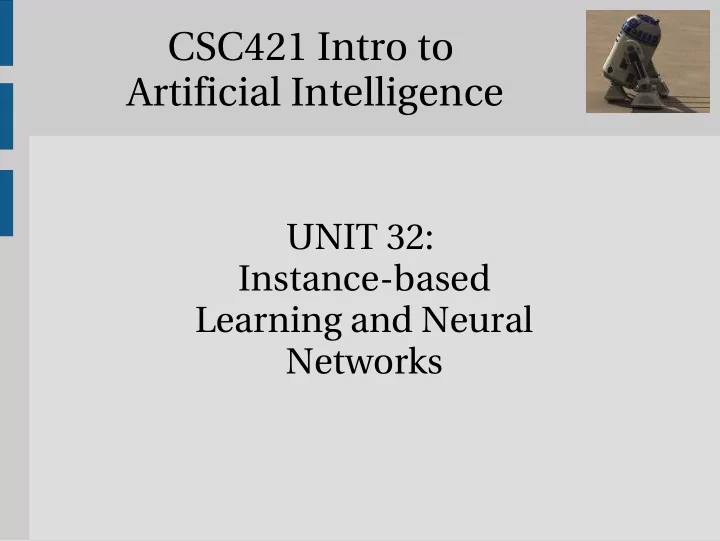

CSC421 Intro to Artificial Intelligence UNIT 32: Instance-based Learning and Neural Networks
Outline Nearest-Neighbhor models Kernel Models Neural Networks Machine Learning using Weka
Classification using single Gaussian
Nearest-Neighbor Key idea: properties of any particular input point x are likely to be similar to the points in the neighborhood of x A form of local density estimation Just enough to fit k points (typically 3-5) Distacnes: Euclidean, Standarize + Euclidean, Mahalanobis, Hamming (discrete features) = #features in which points differ Simple to implement, good performance but doesn't scale well
Kernel Models Each training distance generates a little density function – a kernel function Density estimate = normalized sum of all the little kernel functions P(x) = 1/N ∑ K(x, x i ) Kernel function depends only on distance Typical choice Gaussian (Radial-Basis Functions) Uses all instances
Neural Networks Biological inspiration but more of a simplification than a real model Distributed computation, noisy inputs, learning, regression
McCulloch-Pitts Unit Output is a “squashed” weighted sum of input
Activation Functions Step function Sigmoid 1 / (1 + e -x )
Network Structures Feed-forward networks Single-layer perceptrons Multiple-layer perceptrons Feedforward networks implement functions, have no internal state Recurrent Networks Hopfield networks (holographic associative memory) Boltzmann machines Have internal states can oscillate
Single Layer Perceptron Output units operate separately (no shared weights) Learning by adjusting weights to reduce error
A bit of history Rosenblatt (1957-1960) – Cornell first computer that could “learn” by trial & error Perceptrons – brain, learning, lots of hype Nemesis: Marvin Minsky (MIT) 1969 Perceptrons – proof that simple 3-layer perceptron can not learn the XOR function – postulation that multi-layer can not (turned out not to be true) 10 years of no funding for ANN Later retracted his position
Expressiveness of perceptrons Perceptrons can represent: AND, OR, NOT, majority but not XOR Represents a linear separator in input space
MultiLayer Perceptrons Layers are usually fully connected Number of hidden units choosen empirically Can represent any function
Recommend
More recommend